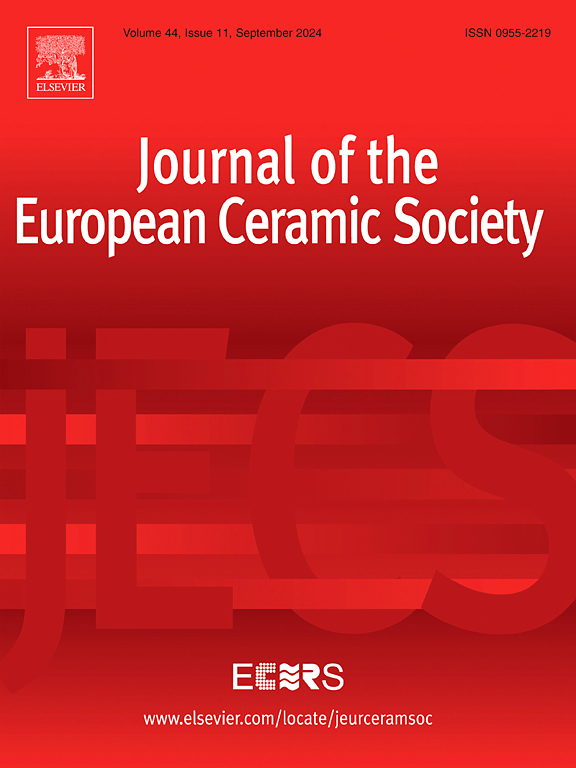Insights into high entropy ceramics under extreme conditions: Ablation behavior and microstructure evolution of C/C-(Ti0.2Zr0.2Hf0.2Nb0.2Ta0.2)C composites
IF 6.2
2区 材料科学
Q1 MATERIALS SCIENCE, CERAMICS
Journal of The European Ceramic Society
Pub Date : 2025-06-10
DOI:10.1016/j.jeurceramsoc.2025.117616
引用次数: 0
Abstract
High entropy ceramics (HECs) exhibit superior oxidation/ablation properties than traditional ceramics, particularly forming a low melting point phase with self-healing effect during the ablation process. Herein, C/C-(Ti0.2Zr0.2Hf0.2Nb0.2Ta0.2)C composites were fabricated by the combination of polymer infiltration pyrolysis (PIP) and chemical vapor infiltration (CVI). Oxyacetylene ablation behavior of C/C-(Ti0.2Zr0.2Hf0.2Nb0.2Ta0.2)C composites was studied systematically under a heat flux of 2.4 MW/m2, resulting in mass and linear recession rates of 0.58 mg/s and 5.13 µm/s, respectively. Due to the unique preferential behavior of multi-components, a dense transition layer containing (Hf, Zr)TiO4 and (Nb, Ta, Ti)C was formed between the oxide layer and the matrix, which alleviated the thermal expansion coefficient mismatch between the oxide layer and the matrix, protecting the internal matrix at ultra-high temperatures. Our work investigated the ablation protection behavior and mechanism of C/C-(Ti0.2Zr0.2Hf0.2Nb0.2Ta0.2)C and broadened the application of HECs in the field of ultra-high temperature ablation resistance for carbon-based composites.
极端条件下的高熵陶瓷:C/C-(Ti0.2Zr0.2Hf0.2Nb0.2Ta0.2)C复合材料的烧蚀行为和微观结构演变
高熵陶瓷(HECs)表现出比传统陶瓷更好的氧化/烧蚀性能,特别是在烧蚀过程中形成具有自愈作用的低熔点相。采用聚合物渗透热解(PIP)和化学气相渗透(CVI)相结合的方法制备了C/C-(Ti0.2Zr0.2Hf0.2Nb0.2Ta0.2)C复合材料。系统地研究了C/C-(Ti0.2Zr0.2Hf0.2Nb0.2Ta0.2)C复合材料在2.4 MW/m2热流密度下的氧乙炔烧蚀行为,得到了质量衰减率为0.58 mg/s,线性衰减率为5.13 µm/s。由于多组分独特的优先行为,在氧化层与基体之间形成含有(Hf, Zr)TiO4和(Nb, Ta, Ti)C的致密过渡层,缓解了氧化层与基体之间热膨胀系数的失配,在超高温下保护了内部基体。研究了C/C-(Ti0.2Zr0.2Hf0.2Nb0.2Ta0.2)C的烧蚀保护行为和机理,拓宽了HECs在碳基复合材料耐超高温烧蚀领域的应用。
本文章由计算机程序翻译,如有差异,请以英文原文为准。
求助全文
约1分钟内获得全文
求助全文
来源期刊

Journal of The European Ceramic Society
工程技术-材料科学:硅酸盐
CiteScore
10.70
自引率
12.30%
发文量
863
审稿时长
35 days
期刊介绍:
The Journal of the European Ceramic Society publishes the results of original research and reviews relating to ceramic materials. Papers of either an experimental or theoretical character will be welcomed on a fully international basis. The emphasis is on novel generic science concerning the relationships between processing, microstructure and properties of polycrystalline ceramics consolidated at high temperature. Papers may relate to any of the conventional categories of ceramic: structural, functional, traditional or composite. The central objective is to sustain a high standard of research quality by means of appropriate reviewing procedures.
 求助内容:
求助内容: 应助结果提醒方式:
应助结果提醒方式:


